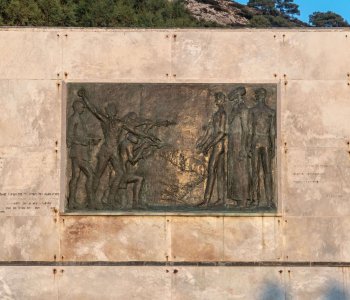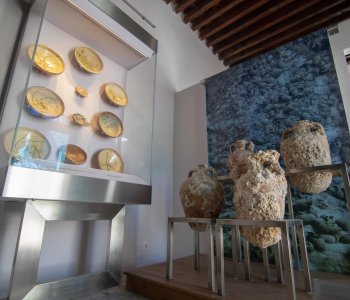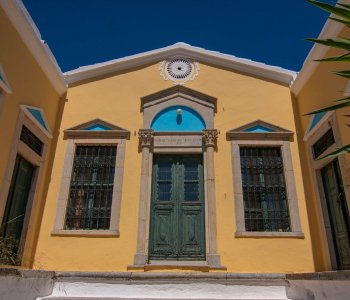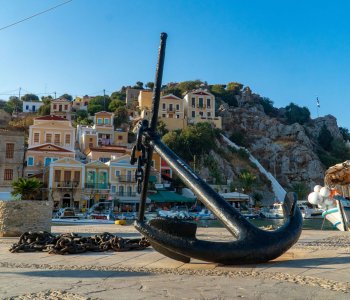The Name of the Island
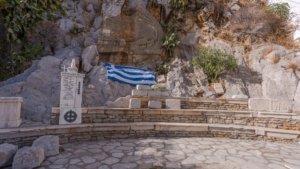
The ancient writers mention several names for the island, such as Metapontis, Aegli, Elkousa, but what has prevailed is the name Symi, which is also mentioned in the Iliad. According to Diodorus, Poseidon, with the mythical figure of Symi, was given a son by the name of Chtonios, who became the leader of the first inhabitants of the island.
According to another version, a minor god named Glafkos kidnaps the daughter of Ialysos, who was called Symi and brings her to the island, and that’s how the island gets its name. Glafkos deals with all maritime arts such as swimming, diving, fishing, and shipbuilding, and it is said that he later also built the famous Argonaut ship, the Argo.
The Trojan War and King Nereus
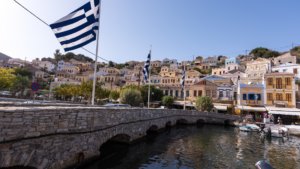
On the list of ships of the Iliad, there is the mention of Homer on the participation of King Nereus of Symi, who led three ships with the other Archaeans to Troy. It was said that he was the most handsome man, after Achilles of course. He was killed in Troy and did not return to the island.
Historical Period
The island after the 11th century BC was inhabited by the Dorians and later took part in the Doric Six Cities alliance along with Kamiros, Lindos, Ialissos, Kos, Knidos, and Halicarnassus. In the sea battle of Salamis, the island was forced to fight like other Greek cities on the side of the Persians. However, after the defeat of Xerxes, it participates in the Athenian Alliance and serves as a station of its military force. In a sea battle in the area between Symi and Knidos, the Spartans defeated the Athenians and built a trophy on the island, parts of which are preserved in the village. So far, no own coins were found in Symi (proof of the independence of an ancient city), but only some from the city of Athens.
Byzantine Period
After the division of the Roman Empire into a western and eastern empire, Symi belongs to the eastern part, which developed into the Byzantine Empire. The famous shipbuilders of the island build the Byzantine warships, and local sailors are used as crew. After the first fall of Constantinople, the Governor of Rhodes, Leon Gavalas, was proclaimed Caesar and founded his state in Rhodes, where Symi belonged. After adventures and after the Genoese pirates became rulers of the island, Symi returns to the Byzantine Empire.
The knights Period
In 1309, the Knights of Saint John and the Grand Master Foulques de Villaret occupied Rhodes and most of the Dodecanese Islands. Symi remained autonomous; residents continued shipbuilding, trade, and shipping. They paid only one tax, which was called “Mortuario,” which was in 1352, 500 Ottoman silver coins. The Knights built a castle in the area of the ancient Acropolis, of which parts with the arms of the Grand Master Jacques de Milly, Ferdinando Zacosta, Emery d’Amboise. Three times (1460, 1485, 1504) the inhabitants of Symi and the knights repulsed the attacks of the Turks.
Ottoman Period
After the conquest of Rhodes in 1522, the inhabitants and the Knights surrender to the Ottoman Turks after securing significant privileges for the island. Suleiman the Magnificent determined that they have to pay an annual sum of money called “Maktou” and be exempted from any other tax. Finally 1755, Osman III set the annual tax with a sultan’s decree at 60,000 Ottoman silver coins.
Tradition has it that the Symiots secured privileges by offering the Sultan bread and other local products. Besides, the community paid 300 silver coins a month to the Ottoman Mudir, a senior administration official who had no authority but symbolized Ottoman rule on the island. They also paid 10,000 guilders to the Venetians to protect them from pirate raids. When the Turks conquered Crete, Symi remained defenceless, and the inhabitants were confined to the village.
The island had autonomy and self-government, all powers were exercised by local rulers, the senators, who were twelve and elected every year at public gatherings. The port of Symi was declared free, and the Symiots stand out as sailors, fishermen and sponge divers, their boats are considered unrivalled fast.
The Greek Revolution of 1821 and the second Ottoman period
Before the revolution of 1821, the Symiots achieved prosperity and lived a comfortable life with their wives. They came in contact with the Greeks who participated in the uprising and helped them with large sums of money. Symi was included in the first administrative system of Greece in 1823 and later in 1828 on behalf of the first Governor Ioannis Kapodistrias, but with the London Protocol in 1830, Symi and the Dodecanese remained outside the borders of the new Greek state.
Because of Symi’s participation in the revolution, the Ottomans increased the tax to 45,000 piastres, abolished the port’s freedom and established a customs office. Despite the adversities, the development of the island continues, two or three storey mansions, ornate churches, monasteries such as Panormitis and Roukouniotis are being built during this period. In Yialos and Horio, there are elementary and secondary schools.
A municipal pharmacy is being made, and there is medical and pharmaceutical care for the residents. Significant is the development of sponge diving, which is operated since 1863 with the diving suit.
Italian conquest and World War II
During the war between the Ottomans and the Italians for Tripoli, now Libya, in 1912 on May 12, the Italians also occupy Symi like the other islands of the Dodecanese. It is a tough time for the Symiots to lose their Asia Minor cultivated estates while the center of trade is now shifting to Rhodes. Another reason for the decline of the island was the replacement of sailing ships with larger and faster steamers.
The sponge fishing has also decreased. Many inhabitants of the island had to emigrate to Rhodes and others to Egypt, America, and Australia. In the last years of the Italian occupation, the fascists with Governor De Vecchi become tougher, prohibit the Greek language in schools and public services and put restrictions on religion and other areas of daily life.
With the outbreak of World War II, things became even more difficult, during which many Simiots took part in the Dodecanese Regiment and fought alongside the Allies. After the Italians capitulated in September 1943, the Germans conquered the island of Symi after two attempts and after repeated bombing raids that destroyed many houses in Yialos and Horio.
On September 24, 1944, before leaving the island, they blew up the Church of Our Lady on the castle and the surrounding area. Symi became the basis of Allied forces operations for the liberation of the rest of the islands.
English Administration and Liberation of Symi
At the end of the war, the German general Otto Wagener came to Symi to sign the protocol of surrender to the Allies, which were represented by Brigadier Moffat, Lieutenant Colonel Auklant and the commander of the Dodecanese battalion Christos Tsigantes. The Dodecanese, however, became part of Greece only on March 7, 1948, after the British administration, which lasted almost three years.
The Allies decided in a meeting in February 1947 in Paris, after a long diplomatic struggle, that the islands will be given to Greece. On October 18, 1948, the royal couple Paul and Frederica visited Symi.

